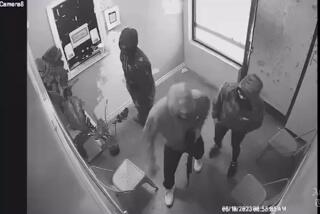Record Cocaine Haul Only ‘a Dent,’ Gates Says
Backed by cardboard boxes containing 556 pounds of cocaine with an estimated street value of more than $158 million, Los Angeles Police Chief Daryl F. Gates said Monday that the record LAPD haul only put a dent in cocaine trafficking in Southern California.
Flanked by Pasadena Police Chief Bob McGowan and federal Drug Enforcement Administration agent Alexander Dovetko, Gates did not minimize the seizure of the quarter of a ton of cocaine and the arrest of 21 suspects in a three-week undercover operation.
But, in response to a reporter’s question at a Parker Center news conference, the chief put the largest cocaine seizure in the Police Department’s history in perspective.
“While it’s important to take 550 pounds off the street--and that will put a dent in it--experienced detectives believe that, at best, our total seizures for the year, which are substantial, we maybe intercept 10%, maybe 15%, of the supply. So there’s plenty of it out there. This will put a dent but not a big dent. . . . Los Angeles is a tremendous consumption point.”
Previous Record
A DEA spokesman said an earlier seizure of 2,100 pounds of cocaine in southern Florida is thought to be the national record. The previous record in Los Angeles was 372 pounds seized last October.
Gates credited Detective Sgt. Walter Burke, a 26-year LAPD veteran who heads the department’s narcotics division, with “doing a magnificent job” in developing the case, culminating Sunday in the arrest of suspects.
Burke described the drug ring, composed mostly of Colombians, as “very sophisticated.” He said the suspects made a couple of mistakes in judgment but none of the mechanical mistakes that the usual drug dealer makes.
“They rented houses in very nice neighborhoods,” he said. “They moved people in to make it look like families. Never used telephones. Everything rented. There is nothing substantial to them at all.”
Gates declined to say how authorities learned about the drug operation, and Burke said he does not know how long the ring had been operating. But, the detective estimated, the smugglers were shipping 1,000 kilograms--more than a ton--of Colombian cocaine perhaps once a month.
Investigators in a joint operation, composed of 35 to 40 officers from the LAPD, Pasadena Police Department, DEA and Los Angeles County district attorney’s office, seized 528 pounds of cocaine at a house on North Michigan Avenue in Pasadena and another 28 pounds at Rosas Electrical Shop in Huntington Park.
Police said that Maria and Nobia Acevedo were arrested at the Michigan Avenue home and that suspects identified as Alvaro Acebedo, Roseo Cardenas, Raul Morales, Carlos Palacios, Mario Palacios, Hector San Martin, Ceasar Bonilla, Fabio Vallejo-Hincapie, Ligia DePalacios and Jairo Santa Maria were arrested at a Yolo Street address in Pasadena.
Santa Maria, 60, was described as the leader of the cocaine ring, but the DEA’s Dovetko cautioned reporters that the identities of those arrested may be fictitious.
Detectives also arrested Andrea Macias, Jairo Duque, Pablo Montoya and Harvey Rivera--identified as residents of Miami and Colombia--a short distance away from the Pasadena house where the largest cache of cocaine was found. The four had been seen dropping off several cardboard boxes at the Michigan Avenue address.
After a parking lot meeting with a suspect who was not arrested, three suspects, identified as Jose Rosas, David Candelaria and Casandra Tolley, were arrested at the intersection of Huntington Drive and San Marino Avenue in San Marino. Two other men, Javier Mesa and Javier Biafara, were taken into custody at an auto repair shop on Bullis Road in Compton.
Weapons Also Seized
All those arrested were booked on charges of possession of cocaine for sale. Besides the cocaine, investigators seized nine handguns, an AR-15 rifle, a shotgun, a 1984 Ford and about $8,000 in cash.
McGowan told The Times that there has been a “tremendous increase” in narcotics trafficking in Pasadena during the past half a dozen years or so. Last year, the police chief said, the City Council agreed to double the size of the department’s drug-enforcement team.
“I don’t think it (drug trafficking) is peculiar to Pasadena. . . . We have some cities surrounding us whose consumption and use of narcotics is probably as great as ours per capita,” McGowan said. “The thing we seem to be is more of a market. People come to Pasadena from Arcadia, from San Marino, from Sierra Madre to purchase their narcotics.
“Our struggle there is not only to deal with people who use it but to try and cut off this market that’s feeding not only Pasadena but several surrounding cities.”
More to Read
Sign up for Essential California
The most important California stories and recommendations in your inbox every morning.
You may occasionally receive promotional content from the Los Angeles Times.










